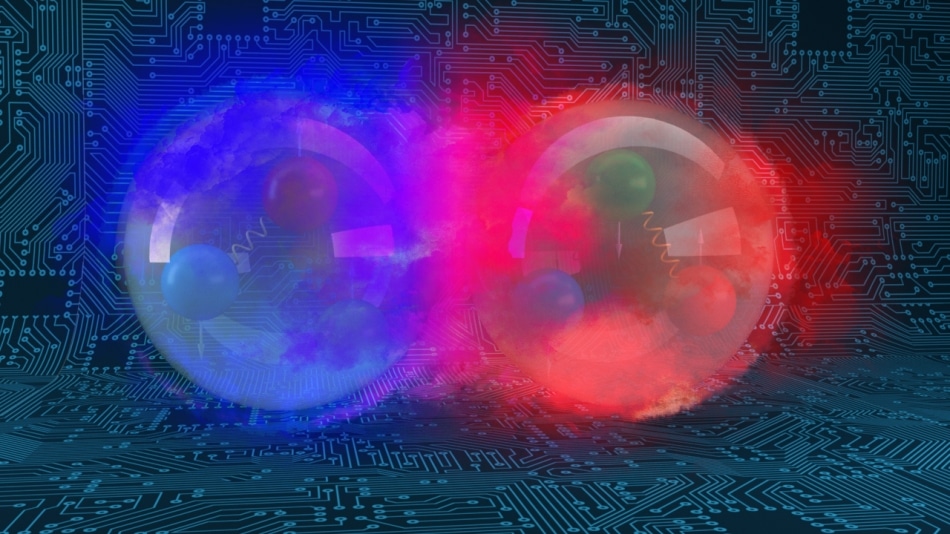May 24 2018
Researchers at the Department of Energy’s Oak Ridge National Laboratory are the first to effectively simulate an atomic nucleus with a quantum computer.
 Graphical representation of a deuteron, the bound state of a proton (red) and a neutron (blue). (Image credit: Andy Sproles/Oak Ridge National Laboratory, U.S. Dept. of Energy)
Graphical representation of a deuteron, the bound state of a proton (red) and a neutron (blue). (Image credit: Andy Sproles/Oak Ridge National Laboratory, U.S. Dept. of Energy)
The results, featured in Physical Review Letters, underscore the ability of quantum systems to work out nuclear physics problems and act as a standard for prospective computations.
In the early 1980s, American theoretical physicist Richard Feynman suggested quantum computing, in which calculations are performed based on the quantum principles of matter. The qubit units used by quantum computers are different from normal computer bits and store information in two-state systems, for example photons or electrons that are believed to be in all possible quantum states simultaneously (a phenomenon called superposition).
“In classical computing, you write in bits of zero and one,” noted Thomas Papenbrock, a theoretical nuclear physicist at the University of Tennessee and ORNL who co-led the project with ORNL quantum information specialist Pavel Lougovski. “But with a qubit, you can have zero, one, and any possible combination of zero and one, so you gain a vast set of possibilities to store data.”
In October 2017, the interdisciplinary ORNL team began developing codes in order to carry out simulations on the Rigetti 19Q and IBM QX5 quantum computers via DOE’s Quantum Testbed Pathfinder project, an attempt to verify and confirm scientific applications on various types of quantum hardware. The researchers developed a code that was first sent to a simulator and then to the cloud-based Rigetti 19Q and IBM QX5systems by means of freely available pyQuil software - a library designed for creating programs in the quantum instruction language.
The researchers carried out over 700,000 quantum computing measurements of the energy of the nuclear bound state of a proton and a neutron - called deuteron. Using these measurements, the team was able to extract the binding energy of deuteron which is the minimum amount of energy required to disassemble it into these subatomic particles. The deuteron, being the simplest composite atomic nucleus, is the best contender for the study.
“Qubits are generic versions of quantum two-state systems. They have no properties of a neutron or a proton to start with,” Lougovski stated. “We can map these properties to qubits and then use them to simulate specific phenomena - in this case, binding energy.”
However, these quantum systems do pose a challenge as scientists must run simulations distantly and then wait for results. Alex McCaskey, ORNL computer science researcher, and Eugene Dumitrescu, ORNL quantum information research scientist¸ ran single measurements 8,000 times each to make sure that their results were statistically accurate.
“It’s really difficult to do this over the internet,” McCaskey remarked. “This algorithm has been done primarily by the hardware vendors themselves, and they can actually touch the machine. They are turning the knobs.”
The researchers also discovered that quantum devices become complicated to work with because of the inherent noise on the chip, which can severely affect results. Dumitrescu and McCaskey effectively used techniques to reduce high error rates, for example, they artificially added more noise to the simulation to study its effect and infer the supposed results with zero noise.
“These systems are really susceptible to noise,” added Gustav Jansen, a computational scientist in the Scientific Computing Group at the Oak Ridge Leadership Computing Facility (OLCF), a DOE Office of Science User Facility located at ORNL. “If particles are coming in and hitting the quantum computer, it can really skew your measurements. These systems aren’t perfect, but in working with them, we can gain a better understanding of the intrinsic errors.”
At the conclusion of the research, the researchers’ results on two and three qubits were within 2% and 3%, respectively, of the right answer on a traditional computer, and this quantum computation turned out to be a pioneering computation in the nuclear physics community.
The proof-of-principle simulation presents new opportunities for computing much heavier nuclei with many more neutrons and protons on quantum systems. Quantum computers may find applications in weather forecasting, artificial intelligence, and cryptography since each extra qubit becomes entangled - or tied inseparably - to the others, exponentially boosting the number of potential outcomes for the quantified state at the end. On the other hand, this very advantage also has unfavorable effects on the system since it is likely that errors also scale exponentially with problem size.
The researchers’ hope is that enhanced hardware will ultimately allow researchers to solve problems that otherwise cannot be solved on conventional high-performance computing resources—not even on the computing resources available at the OLCF, added Papenbrock. Someday, quantum computations of complex nuclei could reveal vital information about the origins of the universe, the formation of heavy elements, and the properties of matter.
Results from the study, titled “Cloud Quantum Computing of an Atomic Nucleus,” were reported in Physical Review Letters.
The paper’s coauthors, all from ORNL, were Eugene F. Dumitrescu, Alex J. McCaskey, Gaute Hagen, Gustav R. Jansen, Titus D. Morris, Thomas Papenbrock, Raphael C. Pooser, David J. Dean, and Pavel Lougovski. Hagen, Morris, Papenbrock, and Pooser also are affiliated with the University of Tennessee, Knoxville.
The team’s research was supported by DOE’s Office of Science. ORNL is managed by UT-Battelle for DOE’s Office of Science. The Office of Science is the single largest supporter of basic research in the physical sciences in the United States and is working to address some of the most pressing challenges of our time.